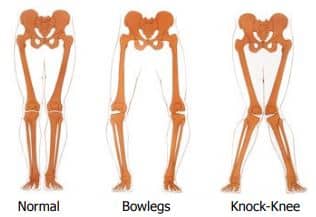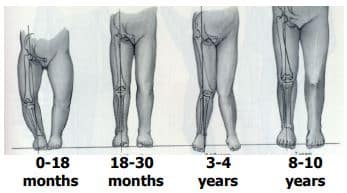
When a child has bowlegs (genu varum), they stand with their feet together with their knees not touching. This causes the legs to curve outward and creates a bow-shape. Compared to a child with knock-knees (genu valgum), they stand with their thighs together with their knees touching, but their ankles are not. Either condition may come from the thighbone (femur), shinbone (tibia), or both.
If your child has bowlegs or knock-knees, there is no need for immediate concern. Both conditions are common and part of the child’s normal growth and development. They will not affect your child’s ability to crawl, walk, run, or play. If either condition causes your child to trip or appear more clumsy, this is also normal and will be outgrown in due time.
However, there is a very small number of children who will need treatment. Learning how a child’s legs change as they grow is important in understanding these conditions. The following is the normal leg growth and development for children from infancy to the age of 10 along with a diagram:

Note: These are generalizations as each child grows at their own rate. Your child may be ahead of or behind the curve of “normal” development.
For the vast majority of children, treatment only involves observation and parental reassurance. The legs will grow and correct themselves over time; other treatment options such as physical therapy, special shoes, and bracing will not have any affect on the legs’ development.
If the child develops a severe enough case of either condition, then your pediatrician will refer you to a pediatric orthopaedic surgeon. There is usually cause for concern if one side is affected more than the other, the deformity is especially severe, or if there is a family history of bowlegs or knock-knees. Two conditions that may require treatment are Rickets and Blount’s diseases.
Rickets disease is a disorder caused by a lack of vitamin D, calcium, or phosphate. It can cause the bones to soften and weaken, and may lead to the development of bowlegs or knock-knees. While less invasive treatments are most often recommended, bracing or surgery may be required depending on the severity.
Blount’s Disease is a disorder brought about by abnormal growth plate in the upper tibia. While the exact cause of Blount’s disease is unknown, it can affect both toddlers and teenagers. Like Rickets disease, the treatment of Blount’s disease depends on the severity of the deformity and the child’s age. It may also require bracing or surgery.
There is no guaranteed method of preventing a child from developing bowlegs or knock-knees as it is typically part of the normal growth pattern. Some children at the extremes of the growth curve may have bowlegs or knock-knees that look more severe. If either is the case, your pediatric orthopaedic surgeon will help you to decide if any type of treatment is necessary.